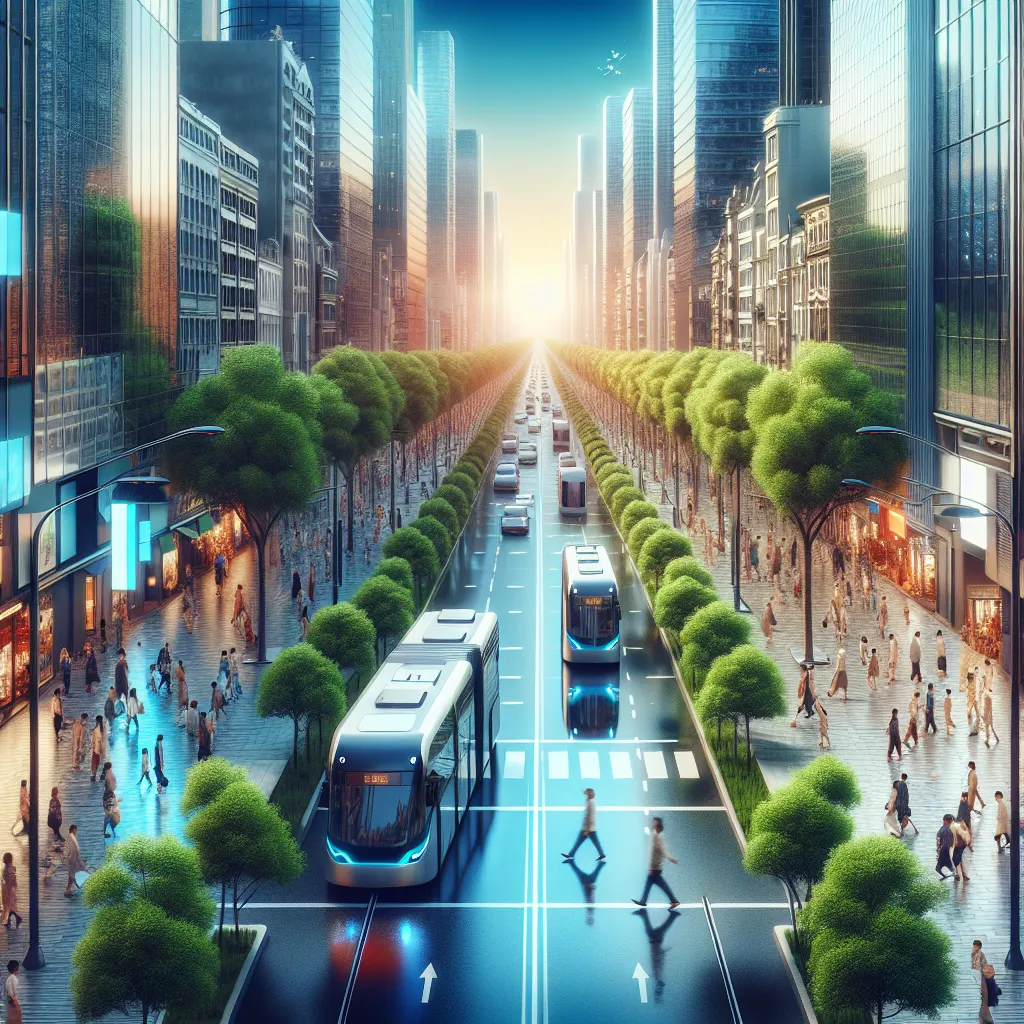Public transportation and its role in reducing air pollution is a topic that frequently appears in IELTS Writing Task 2. Based on past exam trends and the growing global concern for environmental issues, we can expect this theme to continue being relevant in future IELTS tests. Let’s explore this topic through a detailed analysis and sample essays for different band scores.
Nội dung bài viết
 Public transport reducing air pollution
Public transport reducing air pollution
Analyzing the Essay Question
Let’s consider the following question that could potentially appear in an IELTS Writing Task 2:
Some people believe that encouraging the use of public transportation is the best way to reduce air pollution in cities. To what extent do you agree or disagree with this statement?
This question requires you to:
- Understand the claim: Public transportation can significantly reduce air pollution in urban areas.
- Evaluate the extent to which you agree or disagree with this claim.
- Provide reasons and examples to support your position.
Sample Essays for Different Band Scores
Band 8-9 Essay Sample
Air pollution in urban areas is a pressing concern that demands immediate attention and effective solutions. While I agree that promoting public transportation can significantly contribute to reducing air pollution, I believe it is one of several crucial measures that should be implemented in conjunction with other strategies.
Public transportation undoubtedly plays a vital role in mitigating air pollution in cities. Firstly, buses, trains, and trams can transport a large number of people simultaneously, thereby reducing the number of private vehicles on the road. This decrease in individual car usage directly translates to fewer emissions of harmful pollutants such as carbon dioxide and particulate matter. For instance, a single full bus can potentially remove 40-50 cars from the road, dramatically cutting down on exhaust fumes. Moreover, many cities are transitioning to electric or hybrid public transport vehicles, further minimizing the carbon footprint of mass transit systems.
However, encouraging public transportation alone may not be sufficient to combat air pollution comprehensively. Other complementary measures are equally important. Investing in green technologies and renewable energy sources is crucial for reducing industrial emissions, which contribute significantly to urban air pollution. Additionally, implementing strict regulations on vehicle emissions and promoting the use of electric or hybrid cars can further decrease air pollutants from the transportation sector.
Furthermore, urban planning plays a critical role in pollution reduction. Creating pedestrian-friendly zones, developing extensive bicycle lane networks, and designing compact cities that reduce the need for long-distance travel can all contribute to cleaner air. These strategies not only reduce vehicular emissions but also promote healthier lifestyles among city dwellers.
In conclusion, while encouraging public transportation is undoubtedly a powerful tool in the fight against urban air pollution, it should be part of a multifaceted approach. Combining improved public transit with green technologies, stringent regulations, and smart urban planning will yield the most effective results in creating cleaner, more livable cities for future generations.
(Word count: 309)
Band 6-7 Essay Sample
Air pollution in cities is a big problem nowadays, and many people think that encouraging more people to use public transportation is the best way to solve it. I partly agree with this idea because public transport can help reduce pollution, but I also think there are other important solutions we should consider.
Using public transportation can definitely help to reduce air pollution in cities. When more people take buses or trains instead of driving their own cars, there are fewer vehicles on the road. This means less exhaust fumes and less pollution in the air. For example, in my city, when the government improved the bus system, many people started using it instead of driving, and the air quality got better. Also, many cities are now using electric buses, which don’t produce any pollution at all.
However, I don’t think public transportation is the only solution to air pollution. There are other things we can do that are also important. For instance, factories and power plants produce a lot of pollution, so we need to find ways to make them cleaner. Maybe using more solar and wind power could help. Also, we should encourage people to use bicycles or walk for short trips. This is not only good for the air but also for people’s health.
Another thing to consider is that some people might not want to use public transportation because it’s not convenient for them. Maybe the buses don’t go where they need to go, or the schedules don’t fit their work times. So, the government needs to make public transport better and more convenient if they want more people to use it.
In conclusion, I believe that encouraging public transportation is a good way to reduce air pollution in cities, but it’s not the only solution. We need to combine this with other methods like using clean energy and improving city planning to really make a difference in air quality.
(Word count: 309)
Band 5-6 Essay Sample
Air pollution is a big problem in many cities today. Some people think that making more people use public transport is the best way to reduce this pollution. I agree with this idea because I think it can really help make the air cleaner.
When people use buses and trains instead of cars, there is less pollution. This is because one bus can carry many people, so it means fewer cars on the road. Less cars means less smoke from cars, which is good for the air. For example, in my city, when more people started using the new train system, the air became cleaner.
Also, public transport is getting better for the environment. Many cities now have electric buses that don’t make any pollution. This is even better for the air in cities. If more cities use these kinds of buses, it will help a lot to reduce pollution.
But there are some problems with public transport too. Sometimes it’s not convenient for people. The buses might not go to all the places people need to go, or they might be too crowded. This means some people still prefer to use their cars. So, cities need to make public transport better and more comfortable for people to use.
I think there are also other ways to reduce air pollution in cities. For example, planting more trees can help clean the air. Also, factories should use cleaner ways to make things. But I still think that public transport is very important and can make a big difference.
In conclusion, I agree that encouraging people to use public transport more is a very good way to reduce air pollution in cities. It’s not the only way, but it’s a very important one. If more people use buses and trains instead of cars, our cities will have cleaner air and be nicer places to live.
(Word count: 298)
Explaining the Scores for Each Sample Essay
Band 8-9 Essay Explanation
This essay demonstrates excellent writing skills and a comprehensive understanding of the topic. Here’s why it achieves a high band score:
-
Task Response: The essay fully addresses all parts of the task, presenting a clear position with a fully developed response. It discusses both the benefits of public transportation and other complementary measures.
-
Coherence and Cohesion: The ideas are logically organized with clear progression throughout. Each paragraph has a clear central topic, and the essay uses a range of cohesive devices effectively.
-
Lexical Resource: The essay uses a wide range of vocabulary with very natural and sophisticated control of lexical features. Examples include “mitigating air pollution,” “carbon footprint,” and “multifaceted approach.”
-
Grammatical Range and Accuracy: It uses a wide range of structures with full flexibility and accuracy. Complex sentences are used effectively, and there are no noticeable errors.
Band 6-7 Essay Explanation
This essay shows a good attempt at addressing the task, with some areas for improvement:
-
Task Response: The essay addresses the main parts of the task and presents a relevant position, though the ideas could be more fully developed.
-
Coherence and Cohesion: There is a clear overall progression, but some paragraphs could be better connected. The use of cohesive devices is generally good but sometimes repetitive.
-
Lexical Resource: The vocabulary is adequate for the task, with some attempts at less common words like “exhaust fumes” and “convenient.” However, there’s room for more sophisticated vocabulary use.
-
Grammatical Range and Accuracy: The essay uses a mix of simple and complex sentence forms with generally good control. There are a few minor errors, but they don’t impede communication.
Band 5-6 Essay Explanation
This essay demonstrates a modest attempt at addressing the task:
-
Task Response: The essay addresses the task, but the development of ideas is limited. The position is clear but not always well-supported.
-
Coherence and Cohesion: There is a basic structure, but the progression of ideas is not always clear. Paragraphing is present but not always logical.
-
Lexical Resource: The vocabulary is limited but adequate for the task. There are attempts to use less common vocabulary, but with some inaccuracies.
-
Grammatical Range and Accuracy: Sentences are generally simple with limited complexity. There are some errors, but the meaning is usually clear.
Key Vocabulary to Remember
-
Mitigate (verb, /ˈmɪtɪɡeɪt/): To make less severe or serious.
Example: Public transportation can help mitigate air pollution in cities. -
Emission (noun, /ɪˈmɪʃn/): The production and discharge of something, especially gas or radiation.
Example: Electric buses produce zero emissions, making them environmentally friendly. -
Sustainable (adjective, /səˈsteɪnəbl/): Able to be maintained at a certain rate or level.
Example: We need to develop sustainable transportation solutions for our growing cities. -
Infrastructure (noun, /ˈɪnfrəstrʌktʃər/): The basic physical and organizational structures and facilities needed for the operation of a society or enterprise.
Example: Improving public transportation infrastructure is crucial for reducing urban air pollution. -
Incentivize (verb, /ɪnˈsentɪvaɪz/): To provide someone with an incentive for doing something.
Example: Governments should incentivize the use of public transportation through reduced fares and improved services. -
Congestion (noun, /kənˈdʒestʃən/): The state of being overcrowded, especially with traffic.
Example: Effective public transportation can significantly reduce traffic congestion in urban areas. -
Carbon footprint (noun, /ˈkɑːrbən ˈfʊtprɪnt/): The amount of carbon dioxide released into the atmosphere as a result of the activities of a particular individual, organization, or community.
Example: Using public transportation instead of private cars can help reduce your personal carbon footprint.
Conclusion
The topic of public transportation and its role in reducing air pollution is likely to remain relevant in future IELTS Writing Task 2 exams. To prepare effectively, practice writing essays on related themes such as:
- The role of government in promoting sustainable transportation
- Comparing the environmental impact of different modes of transport
- Balancing economic growth with environmental protection in urban areas
- The challenges of implementing effective public transportation systems in developing countries
Remember, the key to improving your IELTS Writing score is consistent practice and self-evaluation. Try writing your own essay on the topic discussed in this article and share it in the comments section below. This active practice will help you refine your writing skills and prepare you for success in your IELTS exam.
For more insights on related topics, check out our articles on how climate change is affecting public health and the role of electric buses in reducing urban pollution.


